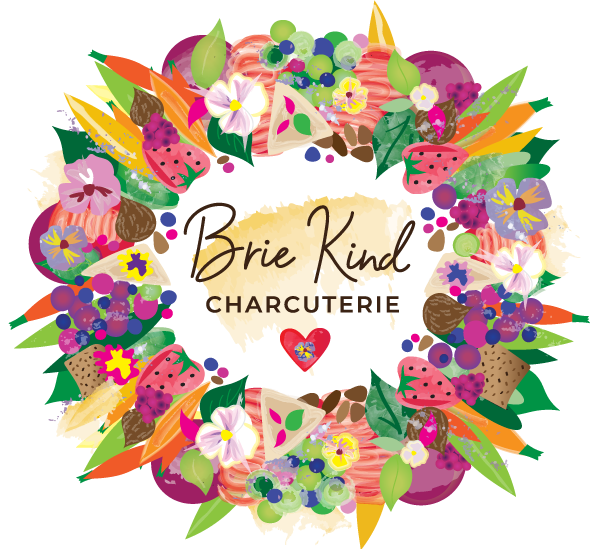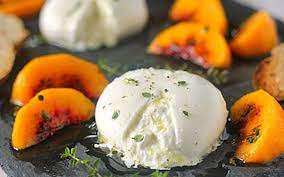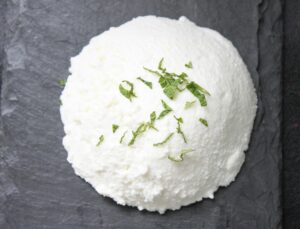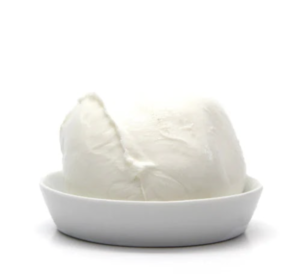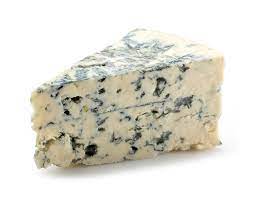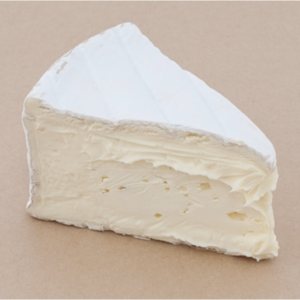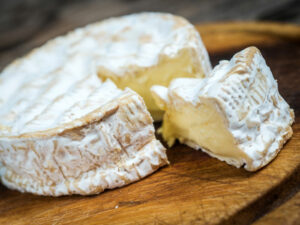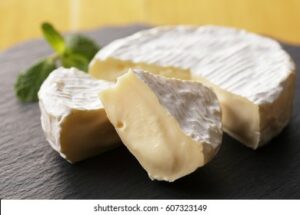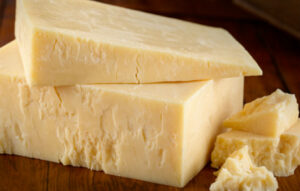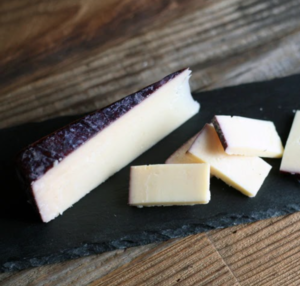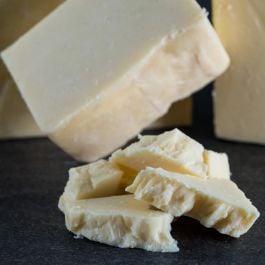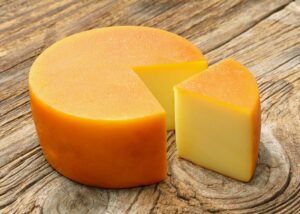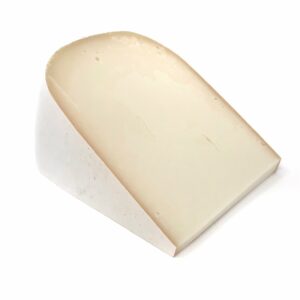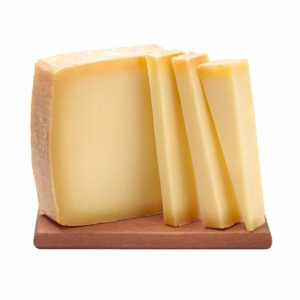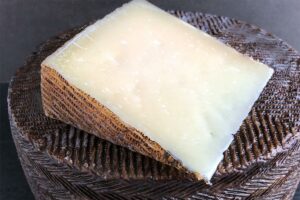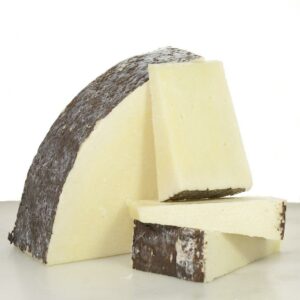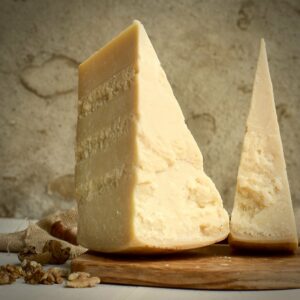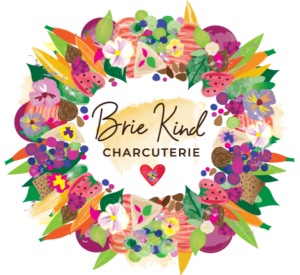Our love of and appreciation for cheese is as expansive as countries are producing excellent, innovative, and quality cheeses. We offer over 30 different types of cheeses on our charcuterie boards. Here are some Board Notes for some of our very favorites. Most of the time, you’ll find at least one, if not more, of these cheeses featured on our Brie Kind Charcuterie boards.
Fresh Cheeses
Burrata
Burrata is a soft cow’s milk cheese that, from the outside, could be mistaken for fresh mozzarella. Both are plump white orbs of Italian cheese, one more solid and elastic than the other. Burrata cheese is distinguishable by its loose texture: small, soft cheese curds and cream are packaged inside an outer shell made of mozzarella. We love the versatility of this cheese in pairing with both sweeter foods (figs, peaches, melons, balsamic) and/or savory foods like tomatoes, basil pesto, and prosciutto.
Chèvre (Goat)
Covering a wide range of cheeses, Chèvre, or Fromage de chévre, describes a proud and bold approach to making artisanal French goats’ cheese – one that has remained committed to tradition for generations. Enjoyed in its fresh variants, it is intense and earthy, with a tangy kick to finish. The texture offers a firm and slightly soft density, with some having a creamy and spreadable consistency. As the cheese ages, the tart aromas and flavors sharpen, becoming increasingly dry and complex. Similarly, the rind hardens, with the interior growing crumbly and dense.
Originally produced in and around the central regions of France, traditional Chèvre is heavily influenced by the climate and pastures on which the goats graze. Depending on its characteristics, a region might invoke flavors suited for white mold cheeses, while others produce milk best enjoyed fresh.
We enjoy pairing the tart flavors of fresh Chèvre with honey, ripe pear, and roasted walnuts or rolled in blueberries and vanilla, cranberries and orange, ground pistachios, and/or sun-dried tomatoes with herbs and seasonings.
Fromage Blanc
Fromage Blanc is a fresh, easy-to-make cheese of French origin. It makes an excellent cheese spread when mixed with herbs and spices. It serves as the base for our delicious Brie Kind dip.
Mozzarella
One of the most delicious and versatile cheeses on earth is fresh mozzarella. It was first made in Italy near Naples from the rich milk of water buffalos (not to be confused with American bison). To this day it is widely known that the best and most highly prized artisanal produced buffalo mozzarella is still found south of Naples near Battipaglia and Caserta where small factories continue centuries-old traditions making buffalo mozzarella fresh daily.
Cow Milk Mozzarella: While still very tender and mild, this mozzarella has a slightly tighter, springier texture. Its flavor is milder than buffalo milk, and it will hold up better to cooking.
Buffalo Milk: This version is more succulent and lacy in texture. Its flavor is more robust, which makes it great for eating at room temperature.
Once cut, the texture differences are even more obvious. The cow (top) has a tighter paste while the buffalo (below) is lacier.
Each version has benefits, but if we’re forced to pick, we chose buffalo for fresh eating.
Soft Ripened/Semi-Soft/Semi-Soft Blue Veined Cheeses
Blue
Whether you prefer a milder creamy or crumbly blue cheese, there are many diverse and exciting options available with a wide range of sharpness, creaminess, and flavors. Creamy Blue Cheese is often a younger variety. Its higher moisture content and percentage butterfat make creamy Blue Cheese perfect for spreading over bread, crackers, or fresh fruit.
Crumbly Blue cheese are those that have less butterfat and have been aged for a longer period of time. The aging process reduces the moisture content in the Blue Cheese and creates a denser curd.
We like to keep this in mind while serving Blue Cheese on our boards. We often pair milder blues with light accompaniments, like acacia honey, grapes, celery, and crusty baguettes. Bold, crumbly Blue Cheeses are well suited to pairing with dark honey, spicy jams and chutneys, and walnuts.
Some of the famous blue cheeses around the world are Danish Blue from Denmark, Roquefort from France, Gorgonzola from Italy, and Stilton from England, but there are many other delicious selections from all across the world.
Brie
Triple cream is one of my favorites with its extra creamy and buttery flavor. To be considered a triple cream, the milk is enhanced with cream until the butterfat content of the cheese is at least 75%. The extra cream gives it a buttery core that’s hard to resist and I can vouch for that. Triple cream brie has a bloomy rind consisting of yeast and mold cultures that are totally edible and delicious so you don’t have to cut this off.
To really enjoy the subtle creamy flavor of triple cream brie, serve it with a sliced baguette and plain crackers. It also pairs deliciously with fruits like sliced apples, grapes, and berries. We like to serve good-quality honey and fig jam for an epic combo of sweet and creamy. We guarantee you’ll be in cheese nirvana when you try this lusciously rich cheese
Goat Brie
Goat brie is even milder than its cow milk inspiration. The rind is remarkably thin, the paste inside like cream, and the flavor sweet and delicate with only the slightest undercurrent of citrus tang that betrays the cheese’s goaty origin.
Camembert
A moist, soft, creamy, surface-ripened cow’s milk cheese. It was first made in the late 18th century at Camembert, Normandy in Northern France. Fresh Camembert cheese is somewhat bland, hard, and crumbly in texture. Young Camembert has a milky and sweet taste. As the cheese matures it forms a smooth, runny interior and a white bloomy rind. It has a rich, buttery flavor. The rind is bloomy white caused by a white fungus, called penicillium candidum, and is meant to be eaten with the cheese.
Semi-Hard/Hard Cheese
Asiago
Asiago cheese is made in the Veneto and Trentino regions in Italy and is sold in fresh and aged varieties. Fresh Asiago is white or pale yellow in color with a thin rind, and small, irregular holes throughout. It has a medium texture, like a firm sponge cake, with a delicately sweet and sour flavor and buttery aroma. Aged Asiago is pale yellow to amber yellow in color with a compact to firm texture. It has a nutty and yeasty aroma with a strong flavor.
BellaVitano®
A Brie Kind favorite, this rich, creamy cheese with its nutty, fruity flavor is a celebrated gold-medal winner. Inspired by traditional, Italian farmstead cheese, BellaVitano Gold begins in the mouth like a premium Parmesan and finishes in award-winning style with hints of melted butter.
This cheese comes in many varieties (and we love them all,) including the original BellaVitano Gold, Balsamic – bathed in Balsamic Vinegar, Black Pepper – rubbed with cracked black peppercorns, Merlot – an ideal combination of wine and cheese, Raspberry – soaked with handcrafted Raspberry Tart ale, Espresso – hand-rubbed with freshly roasted espresso, newcomers Kentucky Bourbon and Tennessee Whiskey (both award-winning).
Cheddar (Farmhouse or Aged Domestic)
Originating in the English village of cheddar, cheddar cheese is a well-loved hard cheese with a nutty, sharp taste. It ranges from sweet and creamy to bitter and sharp in flavor. In general, the longer the cheddar has aged, the sharper the flavor. Mild cheddar is aged for the shortest time and extra sharp the longest.
You’ll see cheddar in both white and orange colors. A number of cheesemakers started adding annatto to the manufacturing process for consistent color, giving the cheese an orange hue without affecting the flavor. The Midwestern region of the United States is known for orange cheddar, while the East coast of the United States and European cheddar are typically white in color.
We like sharp, white cheddar, and it pairs incredibly well with sliced apples and pears and we suggest to add some fresh strawberries, too! This is where you can go crazy with the sliced salami and pepperoni. Set out some whole wheat or sesame crackers and sliced French bread and a pile of roasted almonds.
Gouda
Gouda is a semi-hard cow’s milk cheese originating in the Netherlands. With a nutty, buttery taste infused with notes of caramel, gouda cheese is an all-around crowd-pleaser. This whole milk cheese can also be made with sheep’s milk or goat’s milk and may be enriched with cream for a double cream gouda version. Young gouda has a mild flavor, and as it ages more, the flavor sharpens. It’s typically covered in a waxy coating with a red or yellow wax denoting a young gouda and a black wax identifying an aged gouda. We love a smoked gouda, too.
Goat Gouda
Aged Goudas in general are a revelation for their crunchy, crystalline texture, like some delectable crayon. That plus butterscotch and bourbon flavors make them practical no-brainers as crowd-pleasing cheeses. Aged goat gouda offers an extra twist, and it’s the perfect retort for those who decry goat cheeses.
Goat cheeses made for aging sweeten and mellow with time. Add in Gouda’s own personality and you get a smooth, bone-white paste that feels velvety on the tongue. It’s luxurious dulce de leche in cheese form, sweet and savory with little protein crystals to nibble on.
Gruyère
Gruyère (pronounced “groo-YAIR”) is a smooth-melting type of Swiss cheese that’s made from whole cow’s milk and generally cured for six months or longer. Gruyère is a great table cheese, a term that refers to any cheese that can be eaten in slices, like on a sandwich or as part of a cheese platter.
Named for the town of Gruyères in Switzerland where it was originally made, Gruyère cheese is a firm cheese with a pale yellow color and a rich, creamy, slightly nutty taste. It features a few small holes, or “eyes”, characteristic of Swiss cheese, which are formed by gas bubbles released by the bacteria that are used in making the cheese. Gruyère has fewer eyes, and smaller ones, compared with other varieties of Swiss cheese. A great substitute for Gruyere is Jarlsberg, Emmental, or Comté.
Aged Manchego
Manchego cheese hails from the La Mancha region of Spain. This is a firm sheep’s milk cheese with tangy, nutty, grassy flavors. Although the consistency is not creamy like brie, the lacy interior is high in butterfat, lending it a rich, decadent feel. Manchego has an inedible waxy herringbone rind that’s imprinted during the molding process.
Pecorino-Romano
Pecorino Romano is the ultimate sheep’s milk cheese (“pecora” is the Italian word for sheep) that is typically aged for 8 months to 1 year. Pecorino Romano has a bit of a sharper and saltier taste than Parmesan and stands out nicely on any cheeseboard. Pecorino is usually creamy, crumbly, and firm with pale yellow colors.
The flavor is salty, spicy, and smoky with buttery notes and is easily sliced to form presentable and succulent squares. Pecorino Romano cheese was a staple in the diets of ancient Romans
Parmigiano-Reggiano
Parmigiano-Reggiano – It has been called the “King of Cheeses” and a “practically perfect food.” Parmigiano-Reggiano is a hard, dry cheese made from unpasteurized cow‘s milk. It has a hard pale-golden rind and a straw-colored interior with a rich, sharp flavor. Parmigiano-Reggianos are aged at least two years. Parmesan cheese labeled stravecchio has been aged three years, while stravecchiones are four or more years old. Their complex flavor and extremely granular texture are a result of the long aging.
